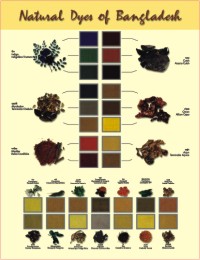Feature
The Alchemic World of Natural Dyes
Sarah Z H
 Like many 19 year olds out there I too thought there really isn't much about our country to be proud of. But I changed my mind and for the next few moments will be trying to change others as well. Most Bangladeshis, particularly the younger ones are often seen to complain about how this country and its culture have failed to live up to their expectations. Like many 19 year olds out there I too thought there really isn't much about our country to be proud of. But I changed my mind and for the next few moments will be trying to change others as well. Most Bangladeshis, particularly the younger ones are often seen to complain about how this country and its culture have failed to live up to their expectations.
This is why there is a shameless imitator in each of us trying to be something we are not. But the true irony lies elsewhere. If pondered, what we will find is not many youngsters are even aware of the rich cultural heritage of the past and its continuity into the present. So much so, very little is done to lift the oblivion off our chests regarding our own glory. As a voice of the young, I can assure the revered and the experienced of our interminable enthusiasm and inquisitiveness in learning more about ourselves and what we are capable of. 'Craft' in Bangladesh has been a household name until industrialization yelled to its waning into extinction. But the eternal love of the people of this land for crafts helped it survive throughout time. Many have dedicated their entire lives to sustain these beautiful practices and enabled the masses to appreciate its elegance. One such unsung yet mesmerizing craft in Bangladesh is the craft of natural dyes. It all started when the 'Indus Valley Civilization' excavated the madder dyed cotton at 'Mohenjodaro' in the region of Asia. Gradually, the craftspeople of the subcontinent developed a wide range of textiles in sophisticated weaves, embroideries along with prints and painted fabrics with fine natural resources. They mingled natural dyes with metallic salts and minerals creating exuberant shades. The aristocracy of this age old craft can be found in museums all over the world.
However, at the time of partition in 1947, only a few natural dye centers outlived the jaws of death in the subcontinent. The then Bengal too had lost all use of natural dyes except some limited production by the isolated tribal communities. It was much later, in 1982 that Bangladesh initiated a research project through BSCIC (Bangladesh Small and Cottage Industries Corporation) in reviving this exquisite craft. Today, it is quite well known in a precise section of people who nurture unconditional love for this extraordinary craft. Even they feel the necessity of young people's association with it in order to sustain the splendor in future. There is an international movement to restore the magnificence of this craft in which Bangladesh is readily playing a prevalent role. The craft of natural dyes is considered to be one of the classic arts of ancient times. It requires traditional skills and indigenous raw materials which are non-pollutant and eco-friendly. The painstaking research and testing of numerous plants, leaves, petals, fruits, rinds, barks, (sawdust) and extracts show that about 30 colors can be produced. The most popular dye producing plants in Bangladesh are Indigo (leaf),Onion(scale leaf), Catechu (wood extract), Pomegranate (rind), Eucalyptus(leaf), Tea (leaf), Betelnut, Madder (stem root), Myrabalan (fruit), Marigold (petal), Rain Tree (saw dust) and Alkanet (skin). Apart from these famous ones, other frequently used natural dyes are Arjun, Henna, Casuarina, Frangipani, Toon, Jackwood and Wild Mangosteen. The color range from these natural resources wavers from reds to vivid blues, from earthly browns to suave olives and even beiges to gorgeous greens. The intermingling of plural colors can produce completely new and exciting shades. The colors are exceptionally versatile and hold pristine antiquity. They signify individual beauty and sensibility. The dyes are used in cotton, rayon, jute, wool and not to forget the all time favorite silk. The eloquence of this craft is deeply rooted into the lives and integral involvement of our people. The techniques used in making these dyes are purely natural. It adheres permanently to the fiber which proves of its unquestionable quality. The craft also embodies original procedures such as boiling, straining, washing, degumming, bleaching and lastly drying in the sun.
Today's world is focusing more on a trend of the potential use of natural goods as they are pollution free and persuasively creative. It is about time, we the young make it a possibility in our lives.
|
